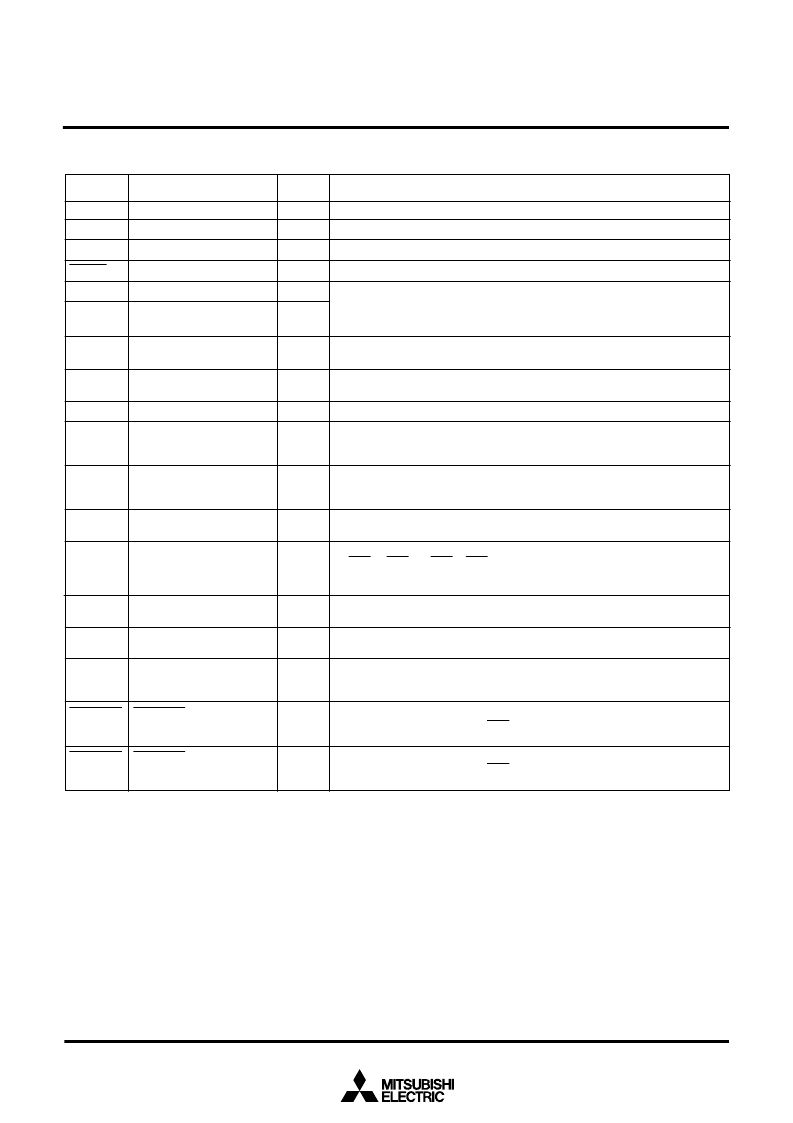- 您現(xiàn)在的位置:買賣IC網(wǎng) > PDF目錄370849 > M37905F8CFP (Mitsubishi Electric Corporation) 16-BIT CMOS MICROCOMPUTER PDF資料下載
參數(shù)資料
| 型號(hào): | M37905F8CFP |
| 廠商: | Mitsubishi Electric Corporation |
| 英文描述: | 16-BIT CMOS MICROCOMPUTER |
| 中文描述: | 16位CMOS微機(jī) |
| 文件頁數(shù): | 7/34頁 |
| 文件大?。?/td> | 362K |
| 代理商: | M37905F8CFP |
第1頁第2頁第3頁第4頁第5頁第6頁當(dāng)前第7頁第8頁第9頁第10頁第11頁第12頁第13頁第14頁第15頁第16頁第17頁第18頁第19頁第20頁第21頁第22頁第23頁第24頁第25頁第26頁第27頁第28頁第29頁第30頁第31頁第32頁第33頁第34頁

7
M37905F8CFP, M37905F8CSP
PRELIMINARY
Notice: This is not a final specification.
Some parametric limits are subject to change.
16-BIT CMOS MICROCOMPUTER
MITSUBISHI MICROCOMPUTERS
PIN DESCRIPTION (MICROCOMPUTER MODE)
Vcc, Vss
MD0
MD1
RESET
X
IN
X
OUT
V
CONT
AVcc,
AVss
V
REF
P1
0
–
P1
7
P2
0
–
P2
7
P4
0
–
P4
7
P5
1
–
P5
3,
P5
5
–
P5
7
P6
0
–
P6
7
P7
0
–
P7
7
P8
0
–
P8
3
P4OUT
CUT
P6OUT
CUT
Power supply input
MD0
MD1
Reset input
Clock input
Clock output
Filter circuit connection
Analog power supply input
Reference voltage input
I/O port P1
I/O port P2
I/O port P4
I/O port P5
I/O port P6
I/O port P7
I/O port P8
P4OUT
CUT
input
P6OUT
CUT
input
—
Input
Input
Input
Input
Output
—
—
Input
I/O
I/O
I/O
I/O
I/O
I/O
I/O
Input
Input
Apply 5 V±0.5 V to Vcc, and 0 V to Vss.
Connect this pin to V
SS
.
Connect this pin to Vss.
The microcomputer is reset when
“
L
”
level is applies to this pin.
These are input and output pins of the internal clock generating circuit. Connect a
ceramic resonator or quartz-crystal oscillator between pins X
IN
and X
OUT
. When an
external clock is used, the clock source should be connected to pin X
IN
, and pin
X
OUT
should be left open.
When using the PLL frequency multiplier, connect this pin to the filter circuit. When
not using the PLL frequency multiplier, this pin should be left open.
Power supply input pins for the A-D and D-A converters. Connect AVcc to Vcc, and
AVss to Vss externally.
This is the reference voltage input pin for the A-D and D-A converters.
Port P1 is an 8-bit I/O port. This port has an I/O direction register, and each pin can
be programmed for input or output. These pins enter the input mode ar reset. These
pins also function as I/O pins of UART0, 1.
In addition to having the same functions as port P1, these pins function as I/O pins
for timers A4 and A9. Also, they can be programmed to function as input pins for tim-
ers B0 to B2.
In addition to having the same functions as port P1, these pins function as I/O pins
for timers A5 to A8. Also, they function as output pins for motor drive waveform.
In addition to having the same functions as port P1, these pins function as input pins
for INT
1
to INT
3
and INT
5
to INT
7
. Also, pins P5
5
to P5
7
function as input pins for tim-
ers B0 to B2 and as input pins for position data in the three-phase waveform mode;
and pins P5
2
and P5
3
function as trigger-input pins in the pulse output port mode.
In addition to having the same functions as port P1, these pins function as I/O pins
for timers A0 to A3. Also, they function as motor drive waveform output pins.
In addition to having the same functions as port P1, these pins function as input pins
for the A-D converter. Also, P7
7
functions as an output pin for the D-A converter.
In addition to having the same functions as port P1, these pins function as input pins
for the A-D converter. Also, these pins function as I/O pins for UART2, and pin P8
0
functions as an output pin for the D-A converter.
This pin has the function to forcibly place port P4 pins in the input mode. Also, this
pin functions as an input pin for INT
0
; and this pin is used to input a signal, which
forcibly cuts off a motor drive waveform output.
This pin has the function to forcibly place port P6 pins in the input mode. Also, this
pin functions as an input pin for INT
4
; and this pin is used to input a signal, which
forcibly cuts off a motor drive waveform output.
Functions
Input/
Output
Name
Pin
相關(guān)PDF資料 |
PDF描述 |
|---|---|
| M37905F8CSP | 16-BIT CMOS MICROCOMPUTER |
| M37905M4C | DIODE SCHOTTKY DUAL COMMON-ANODE 25V 200mW 0.32V-vf 200mA-IFM 1mA-IF 2uA-IR SOT-323 3K/REEL |
| M37905M4C-XXXFP | 16 BIT CMOS MICROCOMPUTER |
| M37905M4C-XXXSP | 16 BIT CMOS MICROCOMPUTER |
| M37905M6C-XXXFP | DIODE SCHOTTKY DUAL-DUAL SERIES 25V 200mW 0.32V-vf 200mA-IFM 1mA-IF 2uA-IR SOT-363 3K/REEL |
相關(guān)代理商/技術(shù)參數(shù) |
參數(shù)描述 |
|---|---|
| M37905F8CSP | 制造商:MITSUBISHI 制造商全稱:Mitsubishi Electric Semiconductor 功能描述:16-BIT CMOS MICROCOMPUTER |
| M37905M4C | 制造商:MITSUBISHI 制造商全稱:Mitsubishi Electric Semiconductor 功能描述:16 BIT CMOS MICROCOMPUTER |
| M37905M4C-XXXFP | 制造商:MITSUBISHI 制造商全稱:Mitsubishi Electric Semiconductor 功能描述:16 BIT CMOS MICROCOMPUTER |
| M37905M4C-XXXSP | 制造商:MITSUBISHI 制造商全稱:Mitsubishi Electric Semiconductor 功能描述:16 BIT CMOS MICROCOMPUTER |
| M37905M6C-XXXFP | 制造商:MITSUBISHI 制造商全稱:Mitsubishi Electric Semiconductor 功能描述:16 BIT CMOS MICROCOMPUTER |
發(fā)布緊急采購,3分鐘左右您將得到回復(fù)。